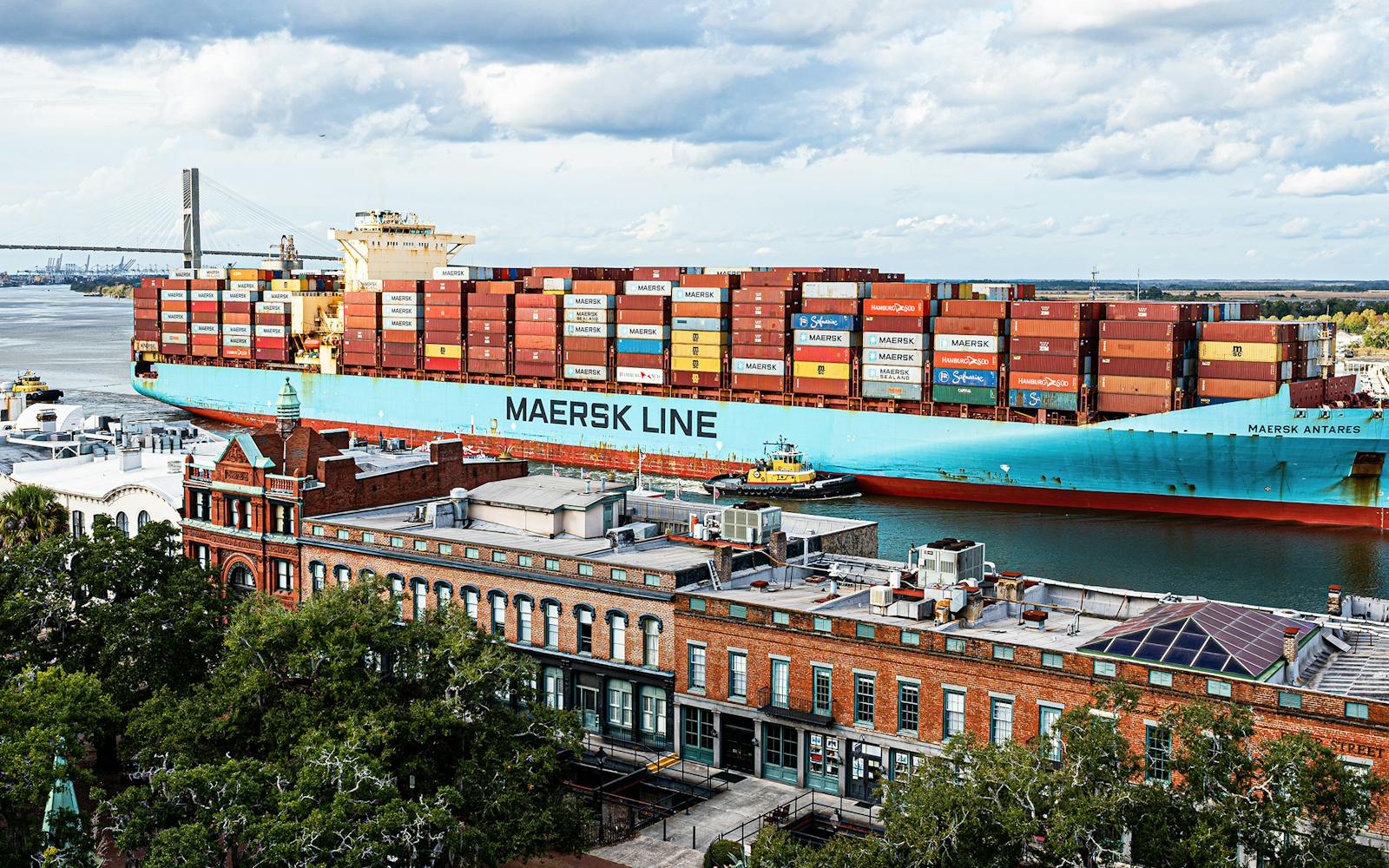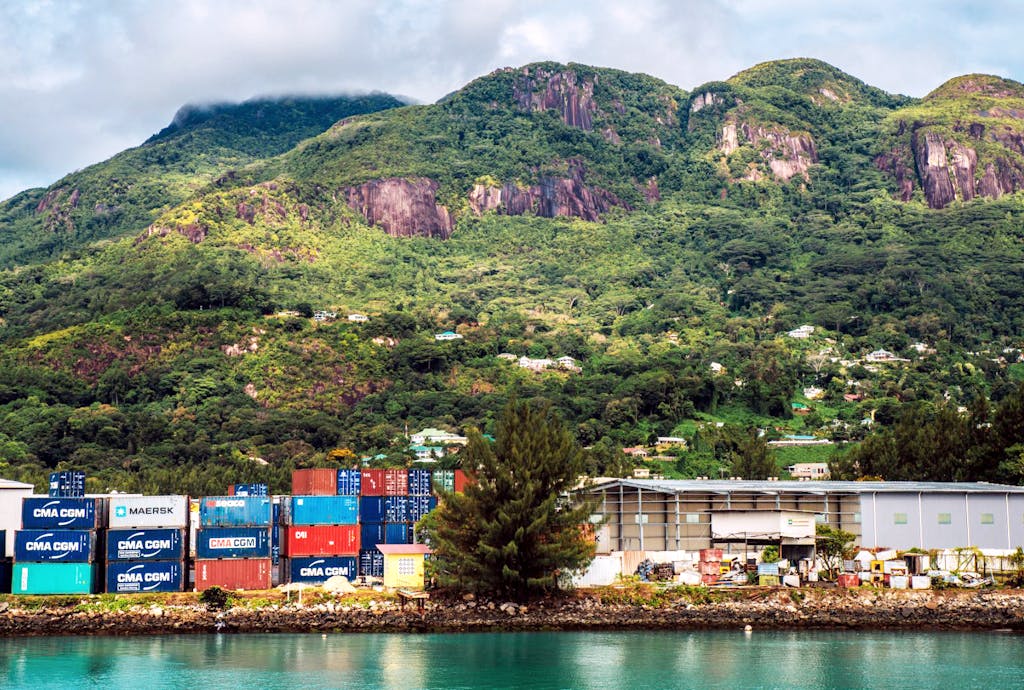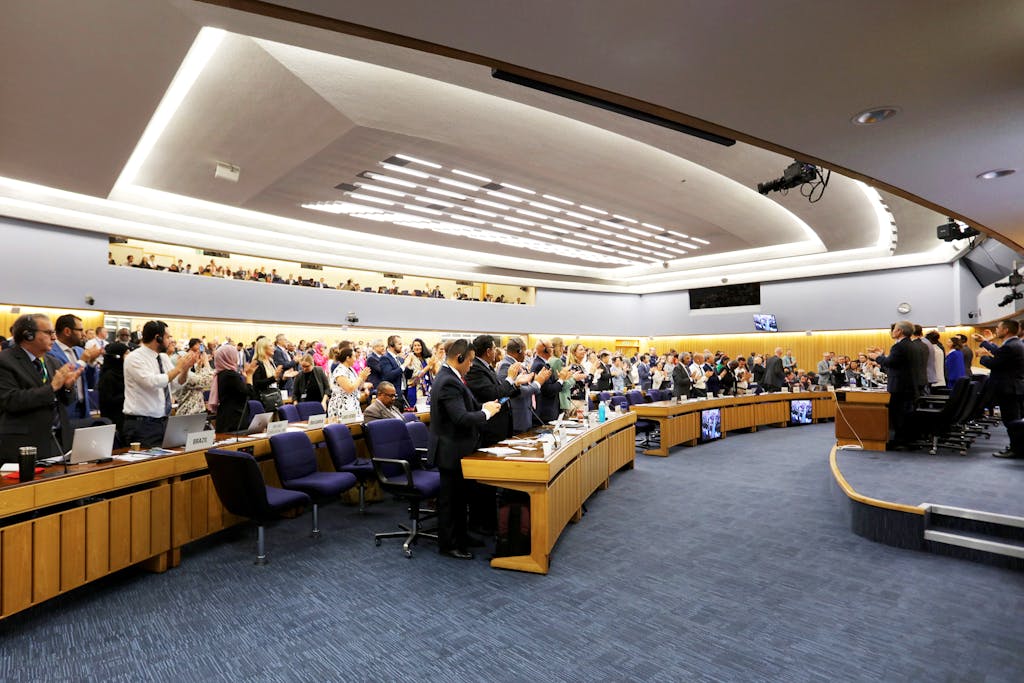
More than 80% of the world’s goods are transported via container ship like this one leaving the port of Savannah, Georgia. Photo: Attie Heunis
For the first time, the global shipping community has agreed to reduce the sector’s greenhouse gas emissions to net zero. The breakthrough came during recent negotiations at the International Maritime Organization, the United Nations agency responsible for regulating transport and pollution on the high seas.
In July, at a highly anticipated meeting in London, International Maritime Organization (IMO) delegates from more than 100 countries reached a consensus to slash the amount of heat-trapping gases produced by the world’s cruise liners, container ships, and bulk cargo carriers. While the revised strategy doesn’t fully align with the targets of the 2015 Paris Agreement, it does represent a new level of ambition for one of the world’s most polluting sectors. Under this new plan, countries have committed to decarbonize the shipping industry by or around 2050, a significant change from previous commitments to cut greenhouse gas (GHG) emissions by just 50% in the same time frame.
“It is not the end goal,” said IMO Secretary-General Kitack Lim. “It is in many ways a starting point for the work that needs to intensify even more over the years and decades ahead of us.”
I spoke with the UN Foundation’s Senior Director for Ocean and Climate Susan Ruffo and the UN Foundation’s Director of Ocean and Climate Kerrlene Wills about what this new strategy could mean for the future of one of the world’s most crucial and complicated industries.
Before we dive in, can you explain what makes the shipping industry — and the IMO — so important for climate action?
Susan: Although most of us rarely think about shipping, it touches all of us every day. About 80% of everything we wear, eat, and use comes to us by ship from all over the world. These goods travel across international waters, which, by definition, are areas that are not under the control of any one country. So shipping is the ultimate global industry, and making changes to that industry requires global cooperation. That is why the IMO was established: to provide a way for governments to collaborate on shipping-related issues ranging from safety to pollution control. That mandate extends to addressing efforts to decarbonize the sector in order to address climate change.
Kerrlene: While shipping currently contributes about 3% of global GHG emissions, if left unregulated this could reach 10% by 2050. One of the biggest challenges to reducing emissions from the shipping industry is the fuel that large vessels use: heavy fuel oil. When it is burned, it emits carbon dioxide, sulfur oxide, and nitrogen oxide, which contribute to global warming, air pollution, and respiratory diseases. Also, these fuels are the tar-like substance that you see on aquatic life and beaches after a tanker has run aground. This occurred most recently in 2020 when a Japanese cargo vessel ran aground on a coral reef off the coast of Mauritius, causing irreversible damage to the area’s marine life. That is why identifying cleaner fuels for the industry is essential to not only curbing shipping emissions, but also to protecting life on land and in the ocean. The IMO is the only body that can set global emissions standards for the shipping industry, and subsequently the standard for the type of fuel that ships run on.

Because they are uniquely vulnerable to climate change and disproportionately affected by the world’s cruise liners and container ships, small island nations are playing a critical role in accelerating the shipping industry’s clean energy transition. Photo: UN Office for Project Services / Integrated Water Resources Management in the Atlantic and Indian Ocean Small Island Developing States (IWRM AIO SIDS)
How is the increasing participation and leadership of small island nations, especially in the Pacific, shaping these discussions?
Susan: Small island nations such as those in the Pacific and Caribbean have long been leaders on ocean and climate issues. They were instrumental in securing the Paris Agreement’s long-term temperature goal of “well below 1.5 degrees” Celsius above preindustrial levels, as well as Sustainable Development Goal 14, which focuses on “life below water.”
Much of the UN Foundation’s work in this space — and our involvement in the recent IMO negotiations specifically — focuses on working with these small island nations, which are really “large ocean states” since their ocean territories are often vast. They are disproportionately affected by climate change, yet, historically, have had less power and voice in decision-making spaces like the IMO.
Kerrlene: Unlike the IMO’s previous strategy, this revised GHG plan includes a specific commitment to a “just and equitable transition,” which was a hard-fought battle by Pacific delegations in particular. The inclusion of this language is important because it recognizes the need to leave no seafarer or country behind when it comes to reducing emissions in the shipping industry. And this breakthrough would not have been possible without the leadership of small island nations in shaping these negotiations.
Susan: Climate change is truly an existential threat for many of these nations, and they provide the world with a moral compass and a sense of urgency. The same is true at the IMO, although historically many of these nations, and many other developing countries, have been underrepresented there. The UN Foundation is working to change that. We have been honored to work with leaders from Pacific states such as the Marshall Islands, Solomon Islands, Tonga, Fiji, Vanuatu, Tuvalu, and Kiribati to support their push for an ambitious and equitable GHG strategy, in collaboration with developing economies around the world.

At the IMO’s headquarters in London, delegates from over 100 countries applaud the passing of a new global agreement to reduce emissions in the shipping industry to net zero. Photo: International Maritime Organization
Discussions about an industry-wide price on carbon generated a lot of buzz at the IMO. Why would a potential levy on GHG emissions be so significant, and what are the next steps?
Susan: There are a couple reasons this is a really important development. First, unlike the UN Framework Convention on Climate Change (UNFCCC), the IMO is actually a regulatory body, so it has the power to set and enforce rules for the global shipping sector. That means its decisions have teeth. Second, although putting a price or levy on GHG emissions is one of the most efficient ways to drive reductions, it can be difficult to pass politically and so it is rarely used. There are currently no global, enforceable carbon levies. That’s why the work that the IMO, as a global regulator, is setting out to do is groundbreaking.
Kerrlene: An equitable GHG pricing mechanism will ensure that the transition to a clean shipping future also addresses the impacts on small island nations and least developed countries in particular. In theory, the pricing mechanism can assist these countries by providing funds for new technologies and for research and development, as well as capacity building and helping to cover costs associated with moving to greener fuels. It could also help generate funds for climate mitigation (reducing carbon emissions) and adaptation (lessening global warming’s impact by altering infrastructure, systems, or behavior). This will be determined in the next phase of the negotiations, which will take place next spring.
Susan: Although it will take some time for the IMO to develop and adopt final regulations, the fact that it agreed to decarbonize shipping by 2050 — and indicated it will use some sort of emissions pricing to drive that process — has already garnered a lot of attention from the industry. Ships have about a 30-year life span, so today’s new vessels will be on the water long after the IMO’s GHG regulations take effect. Burning fossil fuels could get very expensive within the lifetime of these ships, so companies are thinking twice about what kind of fuels they want to use and where they want to invest. I’m hopeful that we’ll start to see a transition to zero-emission vessels happening very soon.
TAKE A DEEPER DIVE
Hear from our experts about the recent IMO meeting and what industry leaders and climate activists alike are saying about how to chart a greener future for global shipping.
from Humanitarian activities – My Blog https://ift.tt/uQn4xvk
via IFTTT


